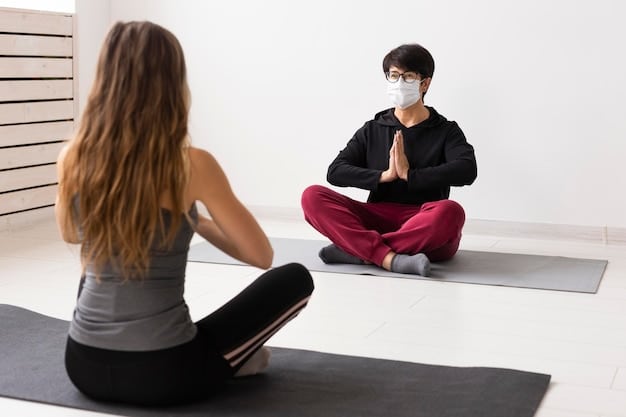K-Pop Idol Vocal Training: 3 Techniques to Improve Range by 15% in 6 Months

Aspiring K-Pop idols can significantly enhance their vocal capabilities by implementing three specific training techniques—diaphragmatic breathing, mixed voice development, and resonant placement—which, when consistently practiced over six months, can lead to an impressive 15% increase in vocal range.
Delving into the demanding world of K-Pop vocal performance reveals a relentless pursuit of perfection. For many aspiring idols, expanding their vocal range is not just an aspiration but a necessity. This article explores K-Pop Idol Vocal Training: 3 Techniques to Improve Your Range by 15% in 6 Months, offering practical insights and actionable strategies to achieve remarkable vocal growth.
The Foundations of K-Pop Vocal Prowess
Before diving into specific techniques, it’s crucial to understand the bedrock of all successful vocal training, particularly in the competitive K-Pop industry. This foundation isn’t merely about hitting high notes; it encompasses a holistic approach to vocal health, control, and endurance. Without a solid understanding of these basics, advanced techniques can be ineffective or even harmful.
K-Pop idols are known for their vibrant performances, which often require extensive vocal gymnastics. This demands not only a wide range but also the stamina to maintain vocal quality through rigorous choreography and long concert schedules. Therefore, training methodologies focus on building a robust and resilient vocal instrument.
Understanding Vocal Mechanics
To truly improve vocal range, one must first grasp the anatomy and physiology of voice production. The vocal cords, diaphragm, resonating cavities, and breath control all play interconnected roles. A trained vocalist learns to manipulate these elements consciously to achieve desired sounds and extend their capabilities.
- Vocal Cords: These vibrate to produce sound; their tension and length determine pitch.
- Diaphragm: Essential for breath support, controlling airflow and sustaining notes.
- Resonators: The chest, head, and nasal cavities amplify and shape the sound.
- Articulation: Clear pronunciation is vital for conveying emotion and lyrics effectively.
A comprehensive training program for K-Pop idols integrates these mechanical understandings into daily practice. This ensures that every exercise targets a specific aspect of vocal production, leading to balanced and sustainable improvement rather than quick, temporary fixes.
In essence, mastering the theoretical and practical aspects of vocal mechanics lays the groundwork for any significant improvement in range. It’s about establishing a deep connection between the mind and the voice, allowing for precise control and nuanced expression.
Technique 1: Mastering Diaphragmatic Breathing
The first and arguably most critical technique for expanding vocal range and sustaining complex K-Pop melodies is diaphragmatic breathing, often referred to as “belly breathing.” Many aspiring singers mistakenly rely on shallow chest breathing, which limits breath support and restricts vocal freedom. Diaphragmatic breathing, conversely, engages the diaphragm muscle, located below the lungs, allowing for deeper, more controlled breaths and a stable foundation for vocal production.
Learning to breathe from the diaphragm not only provides the necessary air volume for long phrases but also reduces tension in the neck and shoulders. This reduction in tension is vital for vocal flexibility, enabling the vocal cords to stretch and vibrate freely across a wider spectrum of notes.
Practical Diaphragm Exercises
Incorporating specific exercises into daily routines can quickly develop diaphragmatic control. These exercises focus on conscious awareness and strengthening the diaphragm’s role in inhalation and exhalation. Consistency is key; even short, daily sessions can yield significant improvements over time.
- Lie Down and Breathe: Lie on your back with one hand on your chest and the other on your abdomen. As you inhale, the hand on your abdomen should rise more than the hand on your chest.
- Hissing Exercise: Take a deep diaphragmatic breath and then slowly exhale with a steady “ssss” sound, aiming to make the hiss last as long as possible.
- Panted Breathing: Rapidly inhale and exhale short, sharp breaths, similar to a dog panting. This helps activate and isolate the diaphragm muscle.
These exercises help build foundational breath support, which directly translates to improved vocal stamina and the ability to navigate higher and lower registers with greater ease. By eliminating tension and maximizing air capacity, a vocalist can push the boundaries of their natural range more safely and effectively.
Diaphragmatic breathing is not just a technique; it’s a fundamental shift in how a K-Pop idol approaches vocal performance. It empowers them to deliver powerful, sustained notes and intricate runs without strain, making it an indispensable tool for extending vocal range.

Technique 2: Developing a Strong Mixed Voice
Achieving a significant increase in vocal range, particularly for K-Pop idols, often hinges on the development of a strong and seamless mixed voice. The mixed voice, sometimes called “mix,” is the coordination of both chest (lower register) and head (upper register) voice mechanisms to produce a sound that is neither overtly chesty nor entirely airy head voice. It bridges the gap between these registers, allowing for a smooth transition across the vocal range without “breaks” or cracks.
Many singers struggle with a noticeable break in their voice as they ascend from their chest voice into their head voice. This phenomenon limits their usable range and can make high notes sound strained or thin. A well-developed mixed voice eliminates this issue, creating an effortlessly connected sound from the lowest to the highest notes.
Exercises for Blending Registers
Building a powerful mixed voice requires targeted practice that encourages the vocal cords to work together efficiently. These exercises help strengthen the muscles responsible for both chest and head voice, promoting a balanced blend.
- Lip Trills and Tongue Trills: These exercises, performed on ascending and descending scales, help relax the vocal mechanism and encourage seamless transitioning by de-emphasizing vocal cord tension.
- “Gee” or “Mee” Scales: Singing on these closed vowels helps gently engage both mechanisms, preventing either chest or head voice from dominating too early.
- Octave Slides: Smoothly sliding up and down an octave on a comfortable vowel sound encourages the vocal cords to adjust gradually between registers without abrupt shifts.
The goal is to cultivate a feeling of ease and connection throughout the entire range, making each note feel like a natural extension of the one before. This blend is crucial for the dynamic and often high-pitched vocal demands of K-Pop music.
Developing a strong mixed voice is a journey of consistency and mindful practice. It allows K-Pop idols to access higher notes with power and resonance, significantly extending their effective vocal range and performance capabilities.
Technique 3: Optimizing Resonant Placement
Beyond breath support and register blending, optimizing resonant placement is the third transformative technique for K-Pop idols seeking to improve their vocal range by 15% in six months. Resonance refers to how sound waves vibrate within the cavities of the head and chest, amplifying and enriching the vocal tone. Proper resonant placement can make high notes feel easier to produce, sound fuller, and carry more power without forcing the vocal cords.
Many untrained singers inadvertently push their vocal cords to achieve volume or reach higher pitches, leading to strain. By learning to direct the sound waves to optimal resonant spaces, particularly the “mask” (the facial area around the nose and eyes) and the roof of the mouth, vocalists can achieve greater projection and brilliance with less effort. This allows for a more efficient use of the voice, extending its reach and endurance.
Targeting Resonators for Range Expansion
Specific exercises help singers become aware of and utilize their resonant cavities more effectively. The aim is to create a vibrant, buzzing sensation in the facial mask, which indicates that the sound is being correctly amplified.
- “Humming” Exercises: Humming with a gentle “mmm” sound, focusing on feeling vibrations around the nose and lips, helps activate mask resonance.
- “Ng” Sound: Singing on an “ng” sound (like the end of the word “sing”) helps direct sound into the nasal passages and upper facial areas.
- “Messa di Voce” with Resonance Focus: Slowly swelling and diminishing a sustained note while maintaining consistent resonant placement can build control and awareness.
By consistently practicing these techniques, K-Pop idols can learn to “place” their voice correctly, making the transition to higher notes feel less strenuous and more acoustically powerful. This approach not only extends their range but also adds a professional polish to their vocal delivery, a hallmark of K-Pop performance.
Optimizing resonant placement is a sophisticated skill that, when combined with diaphragmatic breathing and mixed voice development, forms a powerful trinity for vocal expansion. It allows singers to unlock the full potential of their voice, adding power, clarity, and impressive range to their performances.

Integrating Techniques for Rapid Progress
While each of the three techniques – diaphragmatic breathing, mixed voice development, and resonant placement – is powerful on its own, their true potential for improving vocal range by 15% in six months is unlocked when they are integrated into a cohesive training regimen. Think of them as interdependent pillars supporting a stronger, more versatile vocal instrument. Neglecting one will undoubtedly weaken the others, hindering overall progress.
For K-Pop idols, whose schedules are often packed with dance practice, recording sessions, and promotional activities, efficient and effective training is paramount. A structured approach that consciously combines these techniques during daily practice allows for synergistic improvement, where the whole becomes greater than the sum of its parts.
A Synergistic Practice Routine
A typical vocal warm-up and practice session should flow logically, building from fundamental breath support to complex vocalization, ensuring all three techniques are addressed. This integrated approach ensures that vocal habits are reinforced holistically.
- Breath Warm-up: Begin with 5-10 minutes of diaphragmatic breathing exercises to activate proper breath support. Focus on deep inhalations and controlled exhalations.
- Register Blending: Transition to lip trills, hums, and “gee/mee” scales that smoothly cross the vocal break, strengthening the mixed voice.
- Resonance Activation: Incorporate “ng” sounds and mask resonance exercises, consciously directing sound to the facial resonators.
- Application: Practice K-Pop vocal runs, high notes, and difficult melodic passages, applying all three techniques simultaneously, focusing on ease and connection.
Consistency in this integrated practice is what fuels rapid improvement. Daily, even short, sessions are more beneficial than infrequent long ones. It’s about building muscle memory and refining coordination between various vocal mechanisms.
By consciously layering these three techniques, aspiring K-Pop idols can expect to see noticeable improvements in their vocal range, endurance, and overall vocal quality, laying a strong foundation for their demanding careers.
Sustaining Vocal Health and Preventing Strain
Achieving a 15% increase in vocal range in six months is an ambitious goal that requires intense training, but it must be balanced with a steadfast commitment to vocal health. For K-Pop idols, whose voices are their primary tools, preventing strain and injury is just as crucial as expanding their capabilities. Pushing the voice too hard, too fast, or without proper technique can lead to severe and potentially career-ending issues. This section emphasizes the importance of a mindful approach to vocal training.
Vocal injury often stems from improper technique, overuse, inadequate rest, or a combination of these factors. Therefore, any training program, especially one aiming for rapid improvement, must integrate preventative measures and healthy habits.
Essential Vocal Care Practices
Maintaining vocal health is a daily commitment that extends beyond the practice room. It involves lifestyle choices and a deep understanding of one’s own vocal limits. K-Pop idols often have access to professional vocal coaches and medical specialists, highlighting the importance of expert guidance.
- Hydration: Drink plenty of water throughout the day to keep vocal cords lubricated. Avoid dehydrating beverages like excessive caffeine or alcohol.
- Rest: Ensure adequate sleep and incorporate vocal rest periods, especially after intense training or performances.
- Warm-up & Cool-down: Always warm up the voice before practicing or performing, and cool down afterwards to gradually bring the vocal cords to a resting state.
- Listen to Your Body: Pay attention to signs of vocal fatigue, pain, or hoarseness. Pushing through discomfort can lead to severe injury.
Seeking guidance from experienced vocal coaches is invaluable. They can identify subtle technical errors, provide personalized feedback, and adapt training to individual vocal needs and limitations. This expert oversight ensures that progress is made safely and sustainably.
Ultimately, a 15% increase in vocal range is only valuable if the voice remains healthy and resilient. By prioritizing vocal health and practicing diligently with awareness, K-Pop idols can achieve their range expansion goals without compromising their long-term vocal well-being.
Measuring Progress and Setting Realistic Expectations
Embarking on a six-month journey to improve vocal range by 15% demands not only diligent practice but also a systematic approach to measuring progress and maintaining realistic expectations. Without clear benchmarks and an understanding of individual vocal development, it’s easy to become discouraged or push too hard. For aspiring K-Pop idols, tracking improvement helps validate their efforts and keeps them motivated through challenging training periods.
Vocal progress isn’t always linear. There will be days of rapid improvement, and others where progress feels stagnant. The key is to recognize these fluctuations as part of the natural learning process and to use objective measurements to assess overall trends.
Tools and Strategies for Tracking Range
Modern technology offers several tools that can help singers accurately measure and track their vocal range. These tools provide objective data, which can be invaluable for assessing the effectiveness of training techniques.
- Tuner Apps: Use mobile tuner applications to identify the lowest and highest notes you can comfortably sing. Record these notes to establish a baseline.
- Vocal Range Apps/Software: Dedicated vocal apps often provide visual representations of your range and can track progress over time.
- Regular Recording: Make weekly or bi-weekly recordings of yourself singing scales and specific songs. This allows for subjective assessment of tone, breath control, and ease of production at your vocal extremes.
- Journaling: Keep a vocal journal to note daily practice, any discomfort, and perceived improvements. This helps connect cause and effect in your training.
Remember that a 15% increase is an ambitious but achievable goal, provided the techniques are applied consistently and correctly. This percentage translates to roughly 2-3 semitones (half-steps) for every 10 semitones of current range. For example, if your current range is 2 octaves (24 semitones), a 15% increase would be about 3.6 semitones, adding almost half an octave.
Setting realistic expectations also involves understanding that vocal cords, like any muscle, need time to adapt and strengthen. Patience, persistence, and a focus on healthy technique over forced outcomes are paramount to long-term success in K-Pop idol vocal training.
| Key Technique | Brief Description |
|---|---|
| 🌬️ Diaphragmatic Breathing | Deeper breaths from the diaphragm improve support and reduce tension. |
| 🎤 Mixed Voice Development | Seamless transition between chest and head voice for smooth range. |
| 🔊 Resonant Placement | Directing sound to facial cavities for power and ease in high notes. |
| 📈 Consistent Practice | Regular, integrated training sessions are crucial for achieving goals. |
Frequently Asked Questions
Consistency is paramount for K-Pop idol vocal training. Daily practice sessions, ideally lasting 30-60 minutes, are highly recommended. Frequent short sessions are more effective than infrequent long ones, as they help build muscle memory and reinforce proper technique. Integrating these techniques into warm-ups and cool-downs also maximizes efficiency.
Yes, a 15% increase in vocal range in six months is an ambitious but achievable goal for dedicated individuals, especially with proper guidance. This percentage roughly translates to an additional 2-3 semitones for every 10 semitones of current range. Consistent application of diaphragmatic breathing, mixed voice development, and resonant placement, combined with healthy vocal habits, makes this progress possible.
Rapid vocal improvement, if pursued without proper technique and adequate vocal care, can lead to strain or injury. It’s crucial to always listen to your body, avoid pushing through pain, and prioritize hydration and rest. Working with an experienced vocal coach significantly minimizes these risks by ensuring correct technique and a healthy progression.
While both mixed voice and falsetto involve accessing higher registers, they differ in vocal cord coordination and resulting sound. Falsetto is typically airy and light, with the vocal cords only partially vibrating. Mixed voice, however, is a blend of chest and head voice, allowing the vocal cords to vibrate more fully, producing a more powerful, resonant, and connected sound throughout the vocal range.
A vocal coach is indispensable for this type of intensive training. They provide personalized feedback, identify subtle technical errors, and tailor exercises to individual needs, guiding the singer on proper technique for diaphragmatic breathing, mixed voice, and resonance. Their expertise ensures safe and effective progress, maximizing the chances of achieving the 15% range increase without injury.
Conclusion: The Path to Vocal Mastery
Embarking on the journey of K-Pop idol vocal training, particularly with the aim of boosting vocal range by 15% in six months, is a testament to dedication and disciplined effort. The three core techniques discussed—diaphragmatic breathing, mixed voice development, and optimized resonant placement—form a powerful synergy. When diligently practiced and integrated into a holistic vocal regimen, these methods not only expand a singer’s range but also enhance vocal power, clarity, and endurance. Aspiring idols must remember that consistent, mindful practice combined with an unwavering commitment to vocal health are the true keys to transforming their vocal capabilities and achieving their dreams within the dynamic world of K-Pop.





